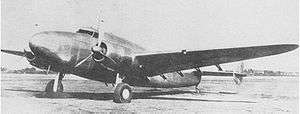Kawasaki Ki-56
| Ki-56 | |
|---|---|
 | |
| Role | Light transport |
| Manufacturer | Kawasaki Kōkūki Kōgyō K.K. |
| Designer | Takeo Doi |
| Introduction | 1940 |
| Produced | 1940-1943 |
| Number built | 121 |
| Developed from | Lockheed Model 14 Super Electra |
The Kawasaki Ki-56 (一式貨物輸送機, Type 1 Freight Transport) was a Japanese two-engine light transport aircraft used during World War II. It was known to the Allies by the reporting name "Thalia". 121 were built between 1940 and 1943.
Design and development
The Kawasaki Ki-56 was derived from the Lockheed Model 14 Super Electra aircraft that the Kawasaki Kokuki Kogyo Kabushiki Kaisha (The Kawasaki Aircraft Engineering Company Limited) had built under licence. In September 1939 Kawasaki was asked by the Koku Hombu to design an improved version as Ki-56.[1] A number was also built by Tachikawa Hikoki K.K..
Operational history
The Japanese invasion of Sumatra in the Dutch East Indies campaign began with a paratroop drop from Ki-56 transports on Airfield P1 and the oil refineries near Palembang. Royal Air Force Hawker Hurricane fighters flying from P1 to locate the Japanese invasion fleet passed the incoming Ki-56s, but thought them to be friendly Lockheed Hudsons (also developed from the Lockheed Model 14) returning from a raid. The defending anti-aircraft gunners at P1 were equally fooled, until the parachutes began to open. Once the AA guns opened fire one transport was shot down, another force-landed, and others veered off course, but the paratroop drop was effective and the airfield and oil installations were overrun.[2][3][4]
Specifications (Ki-56)
Data from Encyclopedia of Military Aircraft;[5] Japanese Aircraft of the Pacific War[6]
General characteristics
- Crew: Four (pilot, co-pilot, navigator, & radio operator)
- Capacity: 14 passengers
- Length: 14.90 m (48 ft 10 in)
- Wingspan: 19.96 m (65 ft 6 in)
- Height: 3.6 m (11 ft 9 in)
- Wing area: 51.2 m² (551 sq ft)
- Empty weight: 4,672 kg (10,300 lb)
- Useful load: 2,400 kg (5,280 lb)
- Loaded weight: 8,024 kg (17,692 lb)
- Powerplant: 2 × Nakajima Ha-25 14-cylinder air-cooled radial engines, 739 kW (990 hp) each
Performance
- Maximum speed: 400 km/h (215 kn, 248 mph) at 3,500 m (11,480 ft)
- Range: 3,300 km (1,782 nmi, 2,060 mi)
- Service ceiling: 8,000 m (26,250 ft)
- Wing loading: 156.7 kg/m² (32.1 lb/(sq ft))
- Power/mass: 0.18 kW/kg (4.05 kg/hp; 8.9 lb/hp)
- Time to altitude: 12 min 38 s to 3,000 metres (9,800 ft)
Armament
- None
See also
Aircraft of comparable role, configuration and era
Related lists
References
- Notes
- ↑ Francillon 1979, p. 108.
- ↑ Routledge, pp. 226–7.
- ↑ Walker, pp. 130–3.
- ↑ Woodburn Kirby, p. 420.
- ↑ Jackson 2002, p. ?.
- ↑ Francillon 1979, p. 109.
- Bibliography
- Francillon, Ph.D., René J. Japanese Aircraft of the Pacific War. London: Putnam & Company, 1970 (Second edition 1979). ISBN 0-370-30251-6.
- Jackson, Robert. The Encyclopedia of Military Aircraft. Parragon, 2002. ISBN 0-7525-8130-9.
- Routledge, Brig N.W., History of the Royal Regiment of Artillery: Anti-Aircraft Artillery 1914–55, London: Royal Artillery Institution/Brassey's, 1994, ISBN 1-85753-099-3
- Walker, Patrick, 6th Heavy Anti-Aircraft Regiment, Royal Artillery, Rev Edn, Gloucester: Choir Press, 2013, ISBN 978-0-9562190-4-6
- Woodburn Kirby, Maj-Gen S. , History of the Second World War, United Kingdom Military Series: The War Against Japan Vol I, The Loss of Singapore, London: HM Stationery Office, 1957/Uckfield: Naval & Military, 2004, ISBN 1-845740-60-2.
External links
| Wikimedia Commons has media related to Kawasaki Ki-56. |